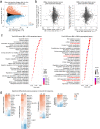Culture expansion of CAR T cells results in aberrant DNA methylation that is associated with adverse clinical outcome
- PMID: 37452103
- PMCID: PMC10457202
- DOI: 10.1038/s41375-023-01966-1
Culture expansion of CAR T cells results in aberrant DNA methylation that is associated with adverse clinical outcome
Abstract
Chimeric antigen receptor (CAR) T cells provide new perspectives for treatment of hematological malignancies. Manufacturing of these cellular products includes culture expansion procedures, which may affect cellular integrity and therapeutic outcome. In this study, we investigated culture-associated epigenetic changes in CAR T cells and found continuous gain of DNAm, particularly within genes that are relevant for T cell function. Hypermethylation in many genes, such as TCF7, RUNX1, and TOX, was reflected by transcriptional downregulation. 332 CG dinucleotides (CpGs) showed an almost linear gain in methylation with cell culture time, albeit neighboring CpGs were not coherently regulated on the same DNA strands. An epigenetic signature based on 14 of these culture-associated CpGs predicted cell culture time across various culture conditions. Notably, even in CAR T cell products of similar culture time higher DNAm levels at these CpGs were associated with significantly reduced long-term survival post transfusion. Our data demonstrate that cell culture expansion of CAR T cells evokes DNA hypermethylation at specific sites in the genome and the signature may also reflect loss of potential in CAR T cell products. Hence, reduced cultivation periods are beneficial to avoid dysfunctional methylation programs that seem to be associated with worse therapeutic outcome.
© 2023. The Author(s).
Conflict of interest statement
The medical faculty of RWTH Aachen and Miltenyi Biotec have submitted a patent application on the epigenetic signatures described in this manuscript. LS is involved in Meneldor B.V. (
Figures





References
Publication types
MeSH terms
LinkOut - more resources
Full Text Sources
Other Literature Sources
Molecular Biology Databases

